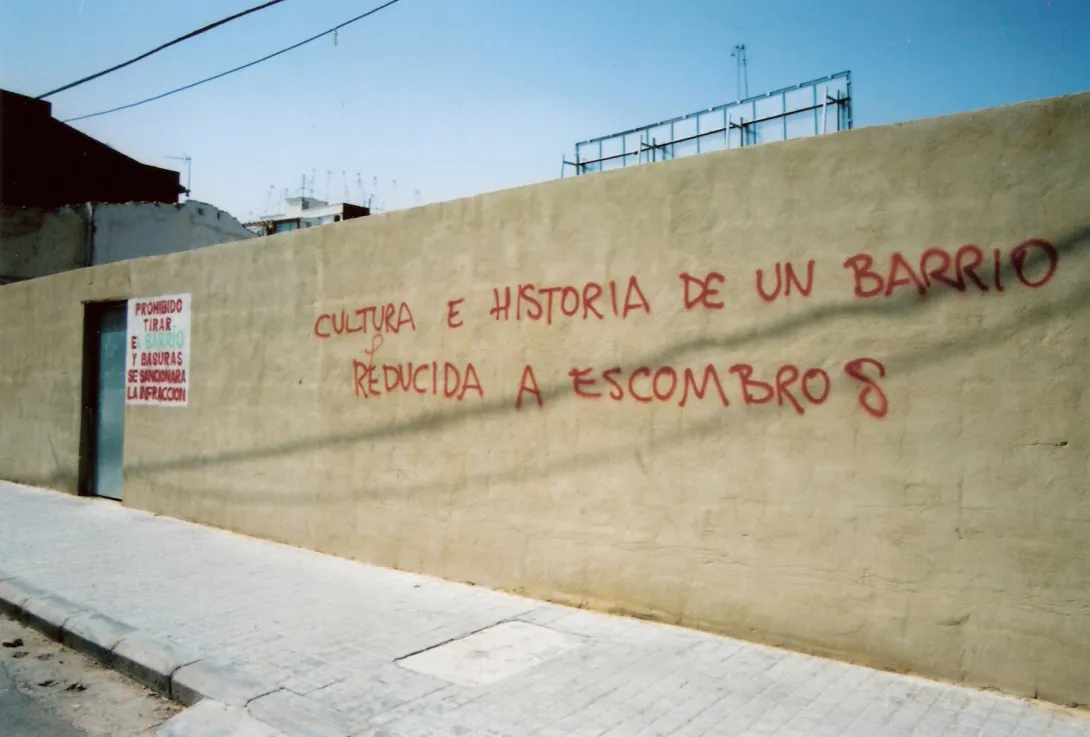GUIDED TOUR AND ROUND TABLE. ACTIVITIES RELATED TO THE EXHIBITION "CABANYAL ARCHIVE. IN MEMORY OF THE PLACE"

17.30 Planta Baixa
Guided tour with the artists Patricia Gómez + María Jesús González and the curator Joana Hurtado Matheu
18.30 Sala d’Actes P3
Round table Before the desertion, this was a neighbourhood. The cases of Cabanyal in Valencia and Poblenou in Barcelona. With Marc Andreu, Tato Herrero, Patricia Gómez + María Jesús González and Joana Hurtado Matheu (moderator).
Among the visual documentation of the Cabanyal Archive, there is a photograph of a concrete wall bordering a plot of land on which is painted “Culture and history of a neighbourhood reduced to rubble”. The title of this talk Before the desertion, this was a neighbourhood, shares the same resonance and was taken from a piece of graffiti that could be read, last year, on a boarded-up door of the old Mesón Poble Nou.
When Patricia Gómez and María Jesús González intervene in a building, its walls have already been talking for a long time and a lot. In this round table, we will contextualise and draw out everything that the walls and the people of two neighbourhoods with similar stories have to say: Cabanyal in Valencia and Poblenou in Barcelona. These two fishing villages that were annexed to their cities both experienced a process of urban transformation as of the 1990s, with such drastic economic and social effects that today they are an example of urban speculation and neighbourhood struggle.
To attend these activities, please email activitats-centredart@bcn.cat to book a place.
Marc Andreu Acebal (Barcelona, 1973) is a historian and journalist. He is the director of the Fundació Cipriano García of the Comissions Obreres trade union of Catalonia and also co-director of the Treball magazine, a contributor to the newspapers El País and Crític and the magazines L’Avenç, Sàpiens and Barcelona Metròpolis. He has a degree in Journalism from UAB (1996) and a PhD in Contemporary History from UB (2014). In 2015, he was awarded the Agustí Duran i Sanpere d’Història Ciutat de Barcelona prize. He was co-director of FAVB’s magazine Carrer, a writer for El Periódico de Catalunya, head of communication for Memorial Democràtic and a technical advisor for Barcelona City Council’s Sant Martí District. He is a member of UB’s GRANMA-CEHI (Analysis of the Current World) research group.
He specialises in urban neighbourhoods and realities, social movements, culture and politics, on the analysis of contemporary Barcelona and the transition in Catalonia. He has collaborated on around 30 books since publishing Barcelona en lluita. El moviment urbà (1965-1996) with Josep Maria Huertas in 1996. He is also the author of La ciutat transportada (1997), Barris, veïns i democràcia. El moviment ciutadà i la reconstrucció de Barcelona (1968-1986) (2015) and Les ciutats invisibles. Viatge a la Catalunya metropolitana (2016) and has contributed to the collective works Paco Candel i els altres (2024) and 22@Barcelona. Un distrito de innovación en disputa (2023), among many others.
Luis Francisco Herrero (Santander, 1957) is an architect whose work has been published in El Croquis, A&V and VIA, among others. He received the architecture award from the Official College of Architects of Valencia for the best construction in the Community of Valencia in 1994-1995 and 2010-2012.
He has a master’s in Heritage Conservation from the Universitat Politècnica de València (UPV) and in 2012, received the European Union Prize for Cultural Heritage/Europa Nostra in the conservation category for his Horno Alto no. 2 project in Sagunto.
He is a citizen activist. He has collaborated with the CAVANILLES and TERRA CRÍTICA groups and was a member of the Salvem el Cabanyal platform until it achieved its objective. His experience with the platform led him to write numerous papers and his doctoral thesis was titled El Cabanyal: permanencias y transformación (2016). He also took part in preparing the Plan Especial del Cabanyal in its draft stage (2017-2018).
He is a full professor at UPV and is a member of the PAISAR research group, which is part of UPV’s Heritage Restoration Institute. He has led and coordinated training courses at UPV, including “Una mirada sobre el Cabanyal” (2001), “La casa sin género” (2006), “Tras Siza” (2008) and “En tres barrios” (2010). Currently, he devotes his teaching efforts to reflecting and educating about the relationship between morphology and its inhabitants.
